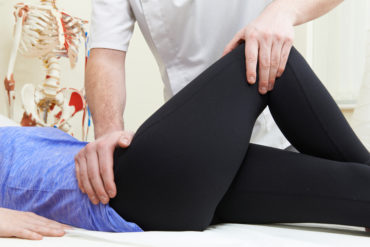- LINCOLN & HICKMAN P: 402.423.7325
- F: 402.423.7328
Your resource for the latest in Physical Therapy, Sports Training and more!
One of the more common injuries we see at Peak Physical Therapy with young athletes, most notably female athletes, is anterior knee pain, or what is also known as Runner’s knee or patellofemoral pain syndrome (PFPS).

PFPS is an irritation on the undersurface of the knee cap. Most people with this condition will complain of pain along the inside or outside of the kneecap or directly below the kneecap. These symptoms are more commonly brought on with running and jumping (sports) or squatting, walking down stairs and prolonged sitting.
So what causes PFPS? Even though pain is felt at the knee, the knee is not usually the culprit. One of the most common causes is weakness in certain muscles of the hip. These particular muscles control the mechanics of the knee, and with weakness, they cause the femur (or upper leg bone) to internally rotate and adduct (knee goes inward) causing the kneecap to track outside of its normal groove. This will cause much irritation and stress to this joint. Functional weakness in these hip muscles can also lead to more serious injuries in sports, such as tearing your ACL. This devastating injury, along with other serious knee injuries, can be the result of poor knee mechanics during landing or cutting. Again, these faulty knee mechanics are the direct result from weakness in the lateral hip muscles which can easily be diagnosed and treated at Peak Physical Therapy.
Another common cause of this condition is pronated feet, or flat feet. This will internally rotate the tibia (or lower leg bone) also causing the kneecap to track outside of its groove. There are other factors which can contribute to this condition. The more common factors are knock knees or tight hamstrings.
So how does one treat this condition? First, you want to make sure to reduce the pain and inflammation, this may involve resting and avoiding painful activities. Then we want to focus on what the true cause is. If this condition is secondary to weakness in the hip muscles, rehab will include strengthening the hip and gluteal muscles which will in turn correct the faulty knee mechanics. We will also focus on stretching any tight musculature. If flat feet are the problem, a proper foot evaluation will be performed. We want to make sure you are wearing proper shoes with good support. Otherwise, foot orthotics can be used to correct the problem and lead to proper knee mechanics.
Anterior knee pain, or PFPS, is definitely treatable with the right diagnosis and proper treatment method. We have seen tremendous results with this condition by implementing the correct treatment plan consisting of proper strengthening and stretching exercises alone with education in proper knee mechanics during activities such as squatting, jumping and landing. If you, or someone you know, are having knee pain with activity, contact Peak Physical Therapy and let us help you get you back to pain-free sports!